Abstract
Epidemiologic and laboratory data suggest that coprodiagnostic methods may fail to detect Cryptosporidium oocysts in stool specimens of infected patients. To improve the efficacy of stool concentration procedures, we modified different steps of the Formalin-ethyl acetate (FEA) stool concentration technique and evaluated these modifications by examining stool samples seeded with known numbers of Cryptosporidium oocysts. Because these modifications failed to improve oocyst detection, we developed a new stool concentration technique that includes FEA sedimentation followed by layering and flotation over hypertonic sodium chloride solution to separate parasites from stool debris. Compared with the standard FEA procedure, this technique improved Cryptosporidium oocyst detection. The sensitivities of the two concentration techniques were similar for diarrheal (watery) stool specimens (100% of watery stool specimens seeded with 5,000 oocysts per g of stool were identified as positive by the new technique, compared with 90% of stools processed by the standard FEA technique). However, the most significant improvement in diagnosis occurred with formed stool specimens that were not fatty; 70 to 90% of formed stool specimens seeded with 5,000 oocysts were identified as positive by the new technique, compared with 0% of specimens processed by the standard FEA technique. One hundred percent of formed specimens seeded with 10,000 oocysts were correctly diagnosed by using the new technique, while 0 to 60% of specimens processed by the standard FEA technique were found positive. Similarly, only 50 to 90% of stool specimens seeded with 50,000 oocysts were identified as positive by using the standard FEA technique, compared with a 100% positive rate by the new technique. The new stool concentration procedure provides enhanced detection of Cryptosporidium oocysts in all stool samples.
Full text
PDF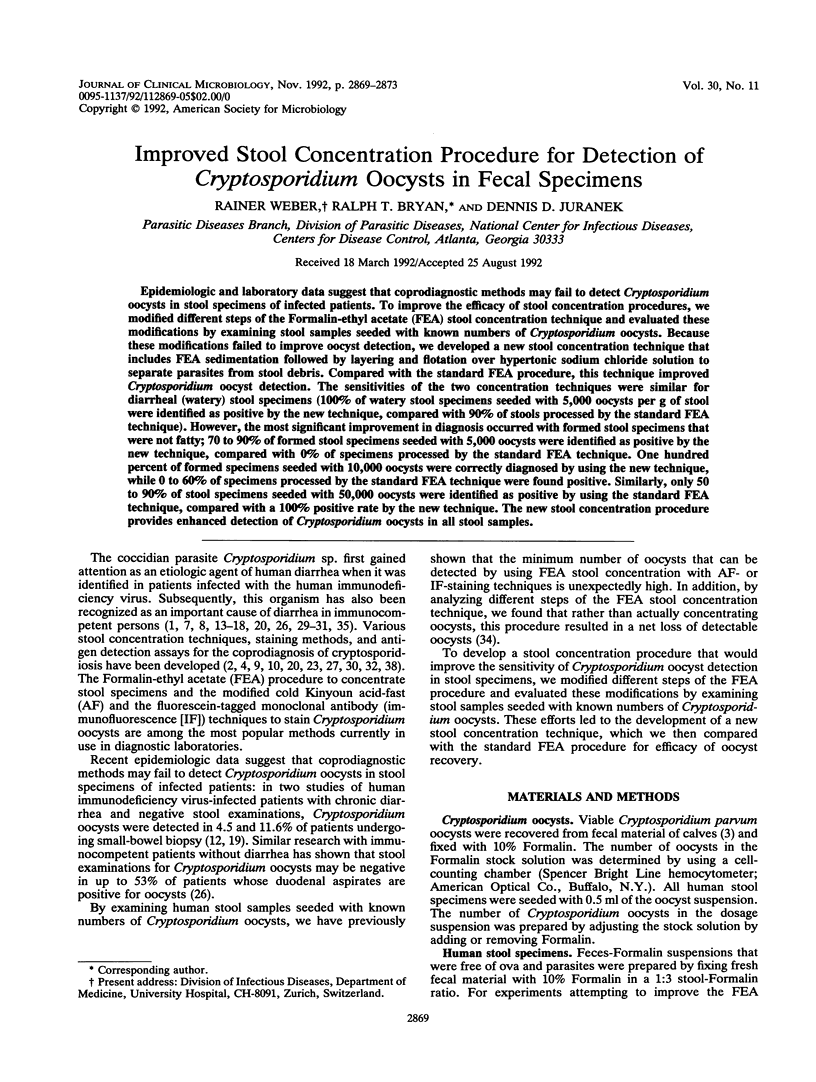
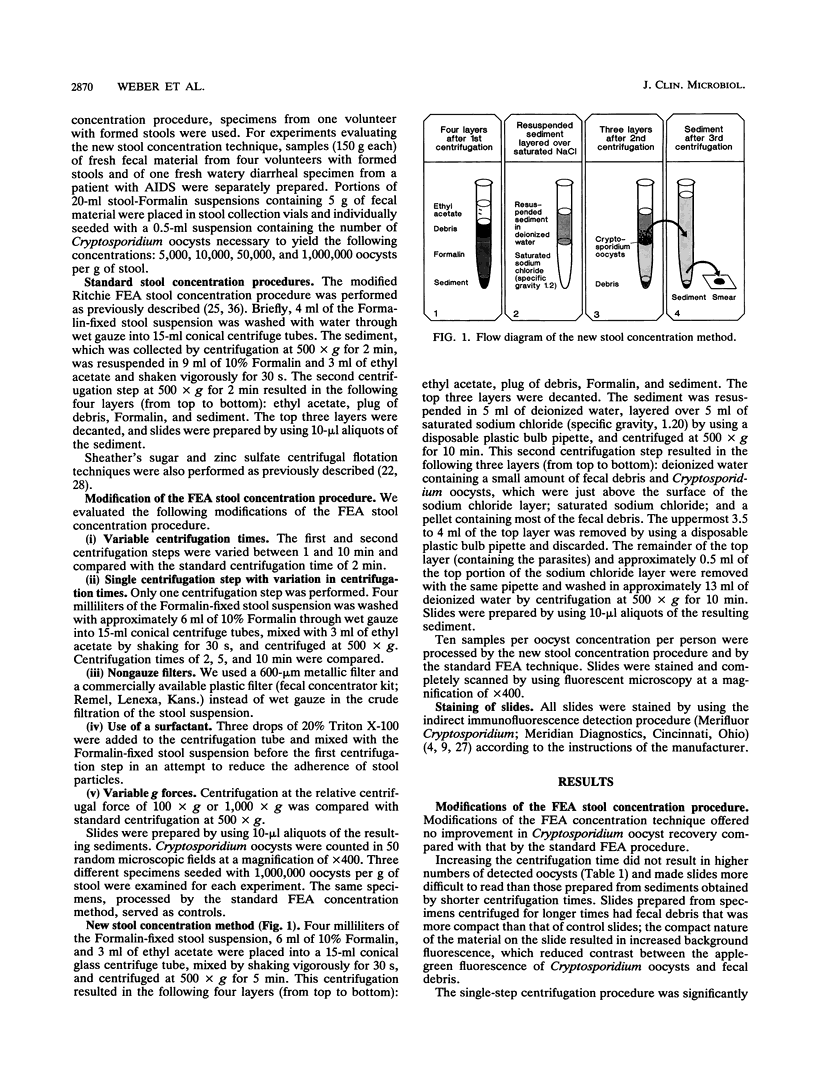
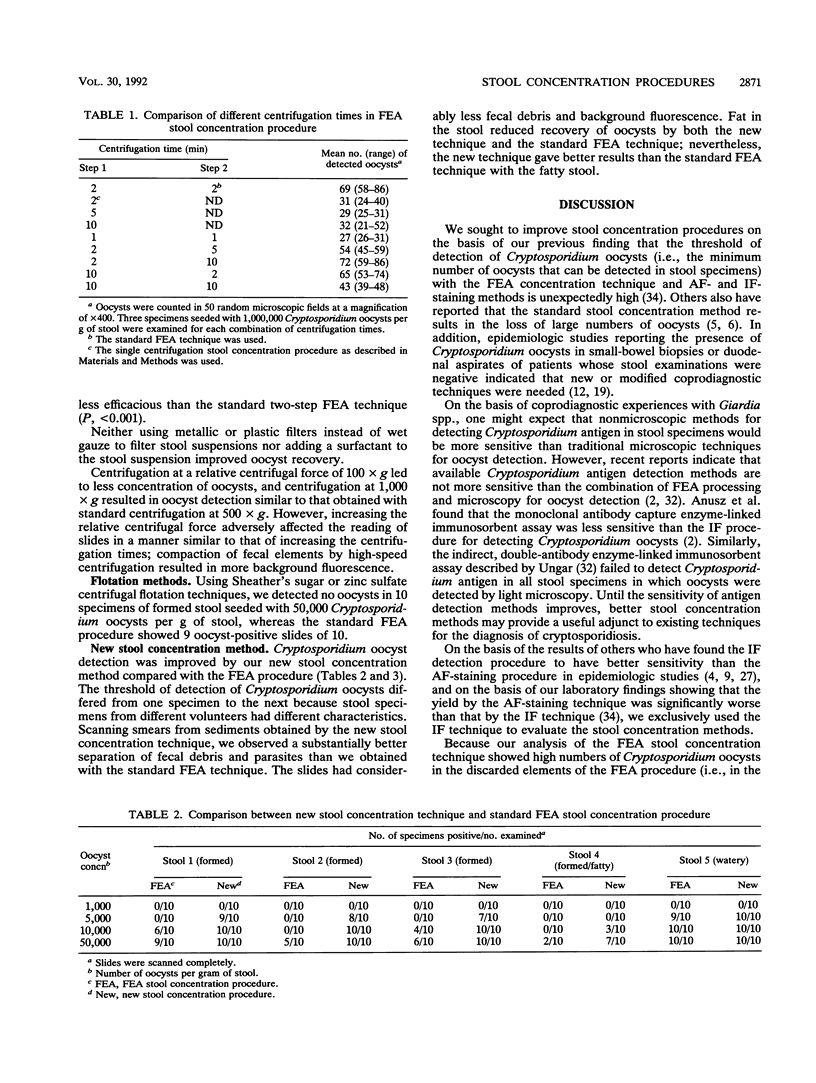
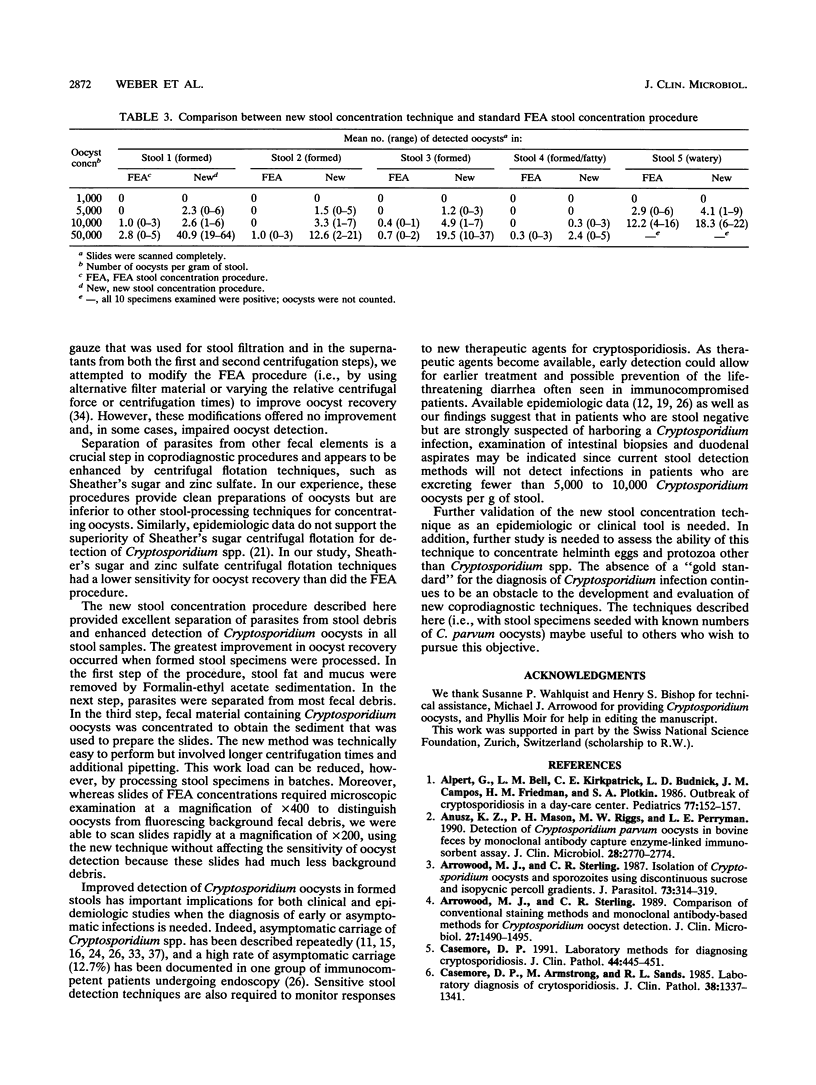
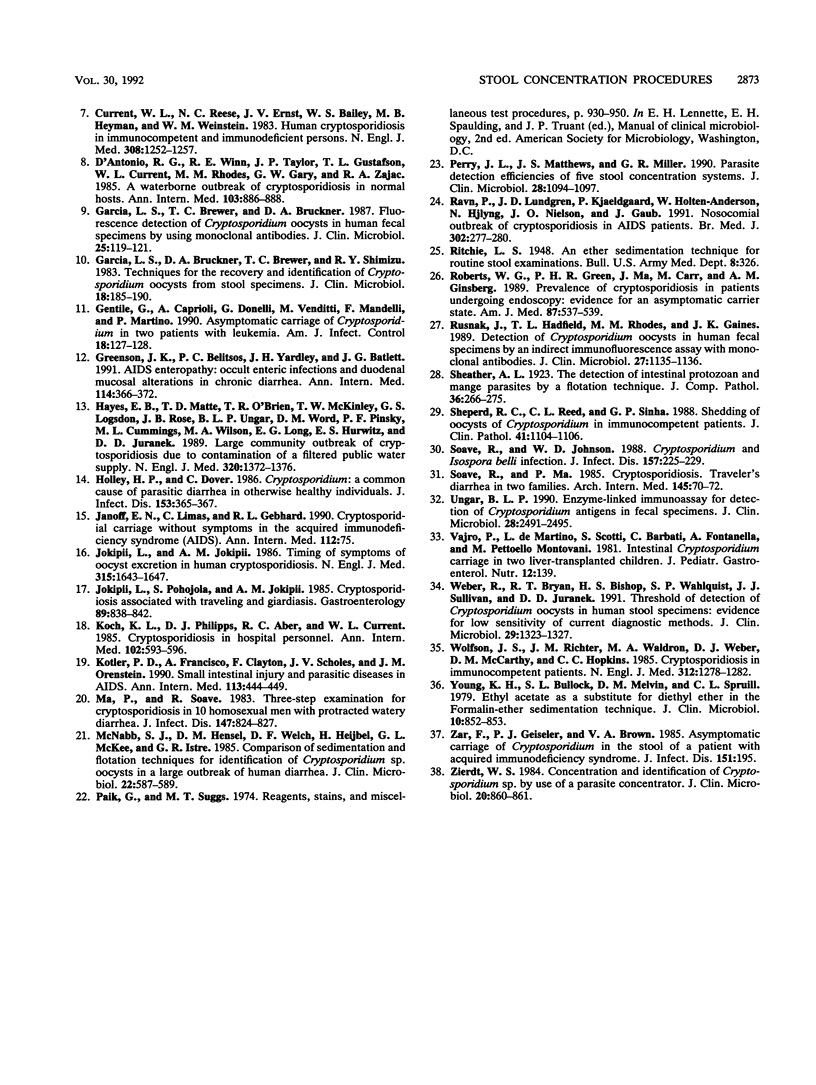
Selected References
These references are in PubMed. This may not be the complete list of references from this article.
- Alpert G., Bell L. M., Kirkpatrick C. E., Budnick L. D., Campos J. M., Friedman H. M., Plotkin S. A. Outbreak of cryptosporidiosis in a day-care center. Pediatrics. 1986 Feb;77(2):152–157. [PubMed] [Google Scholar]
- Anusz K. Z., Mason P. H., Riggs M. W., Perryman L. E. Detection of Cryptosporidium parvum oocysts in bovine feces by monoclonal antibody capture enzyme-linked immunosorbent assay. J Clin Microbiol. 1990 Dec;28(12):2770–2774. doi: 10.1128/jcm.28.12.2770-2774.1990. [DOI] [PMC free article] [PubMed] [Google Scholar]
- Arrowood M. J., Sterling C. R. Comparison of conventional staining methods and monoclonal antibody-based methods for Cryptosporidium oocyst detection. J Clin Microbiol. 1989 Jul;27(7):1490–1495. doi: 10.1128/jcm.27.7.1490-1495.1989. [DOI] [PMC free article] [PubMed] [Google Scholar]
- Arrowood M. J., Sterling C. R. Isolation of Cryptosporidium oocysts and sporozoites using discontinuous sucrose and isopycnic Percoll gradients. J Parasitol. 1987 Apr;73(2):314–319. [PubMed] [Google Scholar]
- Casemore D. P. ACP Broadsheet 128: June 1991. Laboratory methods for diagnosing cryptosporidiosis. J Clin Pathol. 1991 Jun;44(6):445–451. doi: 10.1136/jcp.44.6.445. [DOI] [PMC free article] [PubMed] [Google Scholar]
- Casemore D. P., Armstrong M., Sands R. L. Laboratory diagnosis of cryptosporidiosis. J Clin Pathol. 1985 Dec;38(12):1337–1341. doi: 10.1136/jcp.38.12.1337. [DOI] [PMC free article] [PubMed] [Google Scholar]
- Current W. L., Reese N. C., Ernst J. V., Bailey W. S., Heyman M. B., Weinstein W. M. Human cryptosporidiosis in immunocompetent and immunodeficient persons. Studies of an outbreak and experimental transmission. N Engl J Med. 1983 May 26;308(21):1252–1257. doi: 10.1056/NEJM198305263082102. [DOI] [PubMed] [Google Scholar]
- D'Antonio R. G., Winn R. E., Taylor J. P., Gustafson T. L., Current W. L., Rhodes M. M., Gary G. W., Jr, Zajac R. A. A waterborne outbreak of cryptosporidiosis in normal hosts. Ann Intern Med. 1985 Dec;103(6 ):886–888. doi: 10.7326/0003-4819-103-6-886. [DOI] [PubMed] [Google Scholar]
- Garcia L. S., Brewer T. C., Bruckner D. A. Fluorescence detection of Cryptosporidium oocysts in human fecal specimens by using monoclonal antibodies. J Clin Microbiol. 1987 Jan;25(1):119–121. doi: 10.1128/jcm.25.1.119-121.1987. [DOI] [PMC free article] [PubMed] [Google Scholar]
- Garcia L. S., Bruckner D. A., Brewer T. C., Shimizu R. Y. Techniques for the recovery and identification of Cryptosporidium oocysts from stool specimens. J Clin Microbiol. 1983 Jul;18(1):185–190. doi: 10.1128/jcm.18.1.185-190.1983. [DOI] [PMC free article] [PubMed] [Google Scholar]
- Gentile G., Caprioli A., Donelli G., Venditti M., Mandelli F., Martino P. Asymptomatic carriage of Cryptosporidium in two patients with leukemia. Am J Infect Control. 1990 Apr;18(2):127–128. doi: 10.1016/0196-6553(90)90092-7. [DOI] [PubMed] [Google Scholar]
- Greenson J. K., Belitsos P. C., Yardley J. H., Bartlett J. G. AIDS enteropathy: occult enteric infections and duodenal mucosal alterations in chronic diarrhea. Ann Intern Med. 1991 Mar 1;114(5):366–372. doi: 10.7326/0003-4819-114-5-366. [DOI] [PubMed] [Google Scholar]
- Hayes E. B., Matte T. D., O'Brien T. R., McKinley T. W., Logsdon G. S., Rose J. B., Ungar B. L., Word D. M., Pinsky P. F., Cummings M. L. Large community outbreak of cryptosporidiosis due to contamination of a filtered public water supply. N Engl J Med. 1989 May 25;320(21):1372–1376. doi: 10.1056/NEJM198905253202103. [DOI] [PubMed] [Google Scholar]
- Holley H. P., Jr, Dover C. Cryptosporidium: a common cause of parasitic diarrhea in otherwise healthy individuals. J Infect Dis. 1986 Feb;153(2):365–368. doi: 10.1093/infdis/153.2.365. [DOI] [PubMed] [Google Scholar]
- Janoff E. N., Limas C., Gebhard R. L., Penley K. A. Cryptosporidial carriage without symptoms in the acquired immunodeficiency syndrome (AIDS) Ann Intern Med. 1990 Jan 1;112(1):75–76. doi: 10.7326/0003-4819-112-1-75. [DOI] [PubMed] [Google Scholar]
- Jokipii L., Jokipii A. M. Timing of symptoms and oocyst excretion in human cryptosporidiosis. N Engl J Med. 1986 Dec 25;315(26):1643–1647. doi: 10.1056/NEJM198612253152604. [DOI] [PubMed] [Google Scholar]
- Jokipii L., Pohjola S., Jokipii A. M. Cryptosporidiosis associated with traveling and giardiasis. Gastroenterology. 1985 Oct;89(4):838–842. doi: 10.1016/0016-5085(85)90581-5. [DOI] [PubMed] [Google Scholar]
- Koch K. L., Phillips D. J., Aber R. C., Current W. L. Cryptosporidiosis in hospital personnel. Evidence for person-to-person transmission. Ann Intern Med. 1985 May;102(5):593–596. doi: 10.7326/0003-4819-102-5-593. [DOI] [PubMed] [Google Scholar]
- Kotler D. P., Francisco A., Clayton F., Scholes J. V., Orenstein J. M. Small intestinal injury and parasitic diseases in AIDS. Ann Intern Med. 1990 Sep 15;113(6):444–449. doi: 10.7326/0003-4819-113-6-444. [DOI] [PubMed] [Google Scholar]
- Ma P., Soave R. Three-step stool examination for cryptosporidiosis in 10 homosexual men with protracted watery diarrhea. J Infect Dis. 1983 May;147(5):824–828. doi: 10.1093/infdis/147.5.824. [DOI] [PubMed] [Google Scholar]
- McNabb S. J., Hensel D. M., Welch D. F., Heijbel H., McKee G. L., Istre G. R. Comparison of sedimentation and flotation techniques for identification of Cryptosporidium sp. oocysts in a large outbreak of human diarrhea. J Clin Microbiol. 1985 Oct;22(4):587–589. doi: 10.1128/jcm.22.4.587-589.1985. [DOI] [PMC free article] [PubMed] [Google Scholar]
- Perry J. L., Matthews J. S., Miller G. R. Parasite detection efficiencies of five stool concentration systems. J Clin Microbiol. 1990 Jun;28(6):1094–1097. doi: 10.1128/jcm.28.6.1094-1097.1990. [DOI] [PMC free article] [PubMed] [Google Scholar]
- Ravn P., Lundgren J. D., Kjaeldgaard P., Holten-Anderson W., Højlyng N., Nielsen J. O., Gaub J. Nosocomial outbreak of cryptosporidiosis in AIDS patients. BMJ. 1991 Feb 2;302(6771):277–280. doi: 10.1136/bmj.302.6771.277. [DOI] [PMC free article] [PubMed] [Google Scholar]
- Roberts W. G., Green P. H., Ma J., Carr M., Ginsberg A. M. Prevalence of cryptosporidiosis in patients undergoing endoscopy: evidence for an asymptomatic carrier state. Am J Med. 1989 Nov;87(5):537–539. doi: 10.1016/s0002-9343(89)80610-2. [DOI] [PubMed] [Google Scholar]
- Rusnak J., Hadfield T. L., Rhodes M. M., Gaines J. K. Detection of Cryptosporidium oocysts in human fecal specimens by an indirect immunofluorescence assay with monoclonal antibodies. J Clin Microbiol. 1989 May;27(5):1135–1136. doi: 10.1128/jcm.27.5.1135-1136.1989. [DOI] [PMC free article] [PubMed] [Google Scholar]
- Shepherd R. C., Reed C. L., Sinha G. P. Shedding of oocysts of Cryptosporidium in immunocompetent patients. J Clin Pathol. 1988 Oct;41(10):1104–1106. doi: 10.1136/jcp.41.10.1104. [DOI] [PMC free article] [PubMed] [Google Scholar]
- Soave R., Johnson W. D., Jr Cryptosporidium and Isospora belli infections. J Infect Dis. 1988 Feb;157(2):225–229. doi: 10.1093/infdis/157.2.225. [DOI] [PubMed] [Google Scholar]
- Soave R., Ma P. Cryptosporidiosis. Traveler's diarrhea in two families. Arch Intern Med. 1985 Jan;145(1):70–72. doi: 10.1001/archinte.145.1.70. [DOI] [PubMed] [Google Scholar]
- Ungar B. L. Enzyme-linked immunoassay for detection of Cryptosporidium antigens in fecal specimens. J Clin Microbiol. 1990 Nov;28(11):2491–2495. doi: 10.1128/jcm.28.11.2491-2495.1990. [DOI] [PMC free article] [PubMed] [Google Scholar]
- Vajro P., di Martino L., Scotti S., Barbati C., Fontanella A., Pettoello Mantovani M. Intestinal Cryptosporidium carriage in two liver-transplanted children. J Pediatr Gastroenterol Nutr. 1991 Jan;12(1):139–139. doi: 10.1097/00005176-199101000-00026. [DOI] [PubMed] [Google Scholar]
- Weber R., Bryan R. T., Bishop H. S., Wahlquist S. P., Sullivan J. J., Juranek D. D. Threshold of detection of Cryptosporidium oocysts in human stool specimens: evidence for low sensitivity of current diagnostic methods. J Clin Microbiol. 1991 Jul;29(7):1323–1327. doi: 10.1128/jcm.29.7.1323-1327.1991. [DOI] [PMC free article] [PubMed] [Google Scholar]
- Wolfson J. S., Richter J. M., Waldron M. A., Weber D. J., McCarthy D. M., Hopkins C. C. Cryptosporidiosis in immunocompetent patients. N Engl J Med. 1985 May 16;312(20):1278–1282. doi: 10.1056/NEJM198505163122002. [DOI] [PubMed] [Google Scholar]
- Young K. H., Bullock S. L., Melvin D. M., Spruill C. L. Ethyl acetate as a substitute for diethyl ether in the formalin-ether sedimentation technique. J Clin Microbiol. 1979 Dec;10(6):852–853. doi: 10.1128/jcm.10.6.852-853.1979. [DOI] [PMC free article] [PubMed] [Google Scholar]
- Zar F., Geiseler P. J., Brown V. A. Asymptomatic carriage of cryptosporidium in the stool of a patient with acquired immunodeficiency syndrome. J Infect Dis. 1985 Jan;151(1):195–195. doi: 10.1093/infdis/151.1.195. [DOI] [PubMed] [Google Scholar]
- Zierdt W. S. Concentration and identification of Cryptosporidium sp. by use of a parasite concentrator. J Clin Microbiol. 1984 Nov;20(5):860–861. doi: 10.1128/jcm.20.5.860-861.1984. [DOI] [PMC free article] [PubMed] [Google Scholar]


